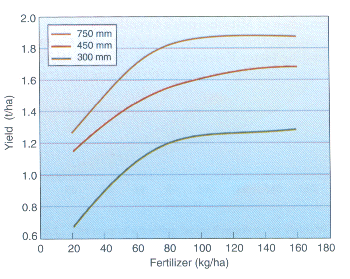Earlier, I wrote that the global total of water--like
the global total of ![]() ,
sun,
and fertilizer
--did not
hem in farming. Nevertheless, water differs from the
other three essentials. The stirring of the atmosphere
assures a fairly even concentration of
,
sun,
and fertilizer
--did not
hem in farming. Nevertheless, water differs from the
other three essentials. The stirring of the atmosphere
assures a fairly even concentration of ![]() everywhere
and all the time. But precipitation delivers to deserts
a fraction of the supply it delivers to jungles. Despite
clouds and latitude, the amount of sunlight falling on
a plot varies little from year to year. But precipitation
delivers a fraction as much water during drought
as during flood. Although fertility
is spread unevenly
over the planet, fractions of a ton of nitrogen, phosphate,
and potash and only a ton or so of lime per
hectare fertilize a hectare of crop. But it needs thousands
of tons of water.
everywhere
and all the time. But precipitation delivers to deserts
a fraction of the supply it delivers to jungles. Despite
clouds and latitude, the amount of sunlight falling on
a plot varies little from year to year. But precipitation
delivers a fraction as much water during drought
as during flood. Although fertility
is spread unevenly
over the planet, fractions of a ton of nitrogen, phosphate,
and potash and only a ton or so of lime per
hectare fertilize a hectare of crop. But it needs thousands
of tons of water.
My estimate that 400 billion could live from the food produced with the evapotranspiration from the land is correct for a global average. But uneven precipitation among places, capricious precipitation among seasons, and vast quantities of irrigation water that must be moved to average it out cloud the sanguine vision.
In a perfect world, the sun distills water and pumps it to mountains where snow stores it, all for free. Then gravity economically carries it in streams down to fields and also carries away the salty water left after the distillation by evapotranspiration. Irrigation has become surpassingly important.
As agronomists, especially soil scientists, have known since the nineteenth century and the preceding section reiterates, ``No production resource is used less efficiently and most ...are used more efficiently with increasing yield level due to further optimizing of growing conditions" (deWit, 1992[deW92]). So as Figure 9.1.1 illustrates happens on practical farms irrigation and other technology complement one another (Ahmad, 1987[Ahm87], 23-27). By raising the potential yield level with new varieties, the Green Revolution underscored the value of irrigation and drainage. During the 1970s, the high prices of supplies caused by the oil crises favored irrigation simply because high yields justified irrigation while marginal areas fell out of production.
 Figure 9.1.1. The complementarity of increasing amounts of
irrigation water and fertilizer. Three curves show
different amounts of applied water, measured as
precipitation in mm (Ahmad, 1987, 23-27).[Ahm87]
Results testify to the profitability of irrigation.
During the twentieth century, irrigation expanded
more than sixfold, and during 1950-1970 it doubled.
It waters about one-sixth of arable land, which yielding
more than other land, produces one-third of the
world's crops (Rangeley, 1987[Ran87], 29-36).
Figure 9.1.1. The complementarity of increasing amounts of
irrigation water and fertilizer. Three curves show
different amounts of applied water, measured as
precipitation in mm (Ahmad, 1987, 23-27).[Ahm87]
Results testify to the profitability of irrigation.
During the twentieth century, irrigation expanded
more than sixfold, and during 1950-1970 it doubled.
It waters about one-sixth of arable land, which yielding
more than other land, produces one-third of the
world's crops (Rangeley, 1987[Ran87], 29-36).